
 Psychedelic Therapy, Johns Hopkins de Baltimore (2008), M. W. Johnson, CC BY-SAThe term psychedelic was coined to refer to psychotropic substances explored for use in psychiatry, but which remain under strict control
Psychedelic Therapy, Johns Hopkins de Baltimore (2008), M. W. Johnson, CC BY-SAThe term psychedelic was coined to refer to psychotropic substances explored for use in psychiatry, but which remain under strict control
Some hallucinogenic substances share a similar psychopharmacological modus operandi. Such is the case of, for instance, dimethyltryptamine, the Amazonian drink ayahuasca, LSD 25, as synthetised by the pharmaceutical company Sandoz, mescaline from the peyote cactus (Lophophora williamsii) or even the psylocybin found in hallucinogenic mushrooms (for instance Psilocybe mexicana). These substances are commonly grouped in the class of psychedelic drugs.
The term “psychedelic” (mind manifestating) was invented by the British psychiatrist Humphry Osmond (1917 -2004) in April 1956 and came into public use soon afterwards, during a meeting of the New York Academy of Sciences. Osmond had suggested this term to account for the effect of LSD and mescaline on the psyche in preference to the term “psychotomimetic” (imitating psychosis) he had used hitherto and which he felt was inappropriate. Inspired by a letter exchange with Aldous Huxley whom he had introduced to mescaline, Osmond coined the term psychedelic (from the Greek ψυχή (psyche, "soul, mind") and δηλείν (delein, "to manifest"). After being acquainted with the biochemical understanding of the mind by his colleague John Smythies (1922 - 2019), who also drew his attention to sundry turn of the century American and European works studying mescaline, Humphry Osmond migrated to Canada in 1951 where he led research on the therapeutic potential of LSD and mescaline for the treatment of mental conditions at Weyburn psychiatric hospital, Saskatchewan. The Province’s socialist administration were at the time offering advantageous, innovation-friendly conditions in order to develop their public health care offer and encourage the establishment of mental health professionals.
Following the rediscovery of in 1953 in Mexico of sacred rituals based on the absorption of psychotropic mushrooms by diverse native American peoples, scientific interest in the potential medical or military applications of psychedelics was about to increase noticeably, especially in Northern America. They would actually be considered for the treatment of alcoholism, depression, anxiety in the face of death, and as disabling weapons neutralising the enemy or even as means of mental control in the context of the Cold War. Between 1950 and 1965 more than 1000 publications focussed on the psilocybin discovered thanks to a collaboration between American amateur ethnologists Gordon and Valentina Wasson (1898 - 1986) and (1901 - 1958), French mycologist Roger Heim (1900 - 1979) Swiss chemist Albert Hofmann (1906 - 2008), as well as on the LSD the latter had discovered.
However, the psychic experience caused by psychedelics was to spread its appeal beyond academic and medical circles. LSD use became widespread in the USA, specifically in the 60s and 70s anti-Vietnam war youth movements. In 1966, this brought about an ideologically and politically driven prohibition dressed up as public health measure. Fuelled by disinformation campaigns, moral panic ensued.
In spite of the very low danger and addiction risk they represent, or their undisputed therapeutic potential, the prohibition on these substances has endured to this day. It rests on three conventions signed by almost all the world’s governments: the 1961 so-called Single Convention on Narcotic Drugs, the 1971 Convention on Psychotropic Substances and the 1988 one against their Illicit Traffic. Now, in the 1971 convention, they are classified as dangerous drugs bereft of therapeutic interest.The resumption of clinical trials since the 2000s is often described as a "psychedelic renaissance", a term proposed in 2012 by the English psychiatrist Ben Sessa. It is accompanied by a worldwide movement of users demanding a change in public policy on drugs. In the US, several States have decriminalised their possession and use. Private investors have also recently taken an interest in the development of psychedelic therapies; a young pharmaceutical company has also patented a new method for the chemical synthesis of psilocybin in anticipation of a liberalisation. Could the future of psychiatry be psychedelic?
Read more in the dictionary : LSD- Truth serum
Read the paper in french : Psychédélique
Références :
Erika Dyck, Psychedelic Psychiatry – LSD from Clinic to Campus, 1re éd., Baltimore, Md, Johns Hopkins University Press, 2008.
Aldous Huxley, Les portes de la perception, s.l., 10 X 18, 2001.
To quote this paper : Vincent Verroust, "Psychedélic" in Hervé Guillemain, DicoPolHiS, Le Mans Université, 2021.